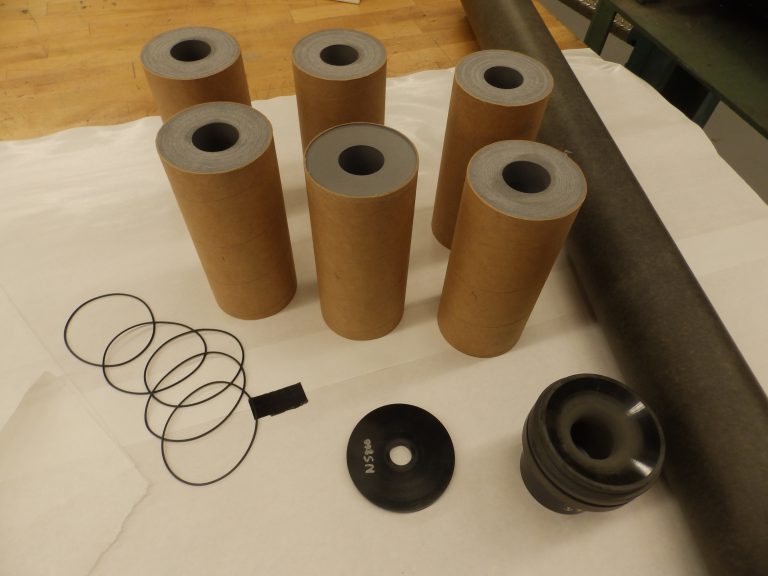August Fun Fly
The weather was much more cooperative with cooler temperatures and lighter winds. I camped out the night before, so my team and I could get started first thing in the morning when the 8:00 waiver opened. Unfortunately, dense fog kept the range closed until almost 11:00. At that point, we only had 3 hours to launch our projects instead of 6, so there was a bit of a time crunch. Like before, the focus of these launches was to fly payloads for Honeywell and the National Security Campus in Kansas City. They get their payloads launched, and our team gains valuable materials and experience with rockets on this large a scale.
We flew TestArticle_FlightConfig_RevIR again first thing on an M3400, an identical flight from the previous launch. Same payload, same electronics, very straightforward. However, this time the main did not deploy near apogee because we added 4 extra shear pins at the main parachute separation plane, so that appears to have done the trick. It deployed at around 1500 feet as expected, and we recovered the rocket and transferred the parachutes over. Almost all parts of these rockets were completely separate for the sake of redundancy, but the vendor for our second main parachute didn’t send it out in time, so we had to share that between rockets.

As I folded the parachutes, the rest of our team worked on extracting the first payload and mating the second rocket, TestArticle_FlightConfig_RevA, an extended version of the previous to accommodate a CTI 6GXL motor. While they finished prepping that rocket for flight, I got my multistage rocket, Mach Wave II Stage, on the launchpad! I did all of its preparation the previous evening, so on launch day all I had to do was arm the Jolly Logic chute release and carry it to the pad. From the last attempt in February, I replaced all of the twist and tape wire switches with screw and rotary switches which made arming the electronics take a fraction of the time and didn’t necessitate a ladder. Additionally, I decided to drag separate the stages (with a backup charge as well), so I didn’t have the complication of mating the stages while the rail was horizontal, trying to balance the sustainer against the booster. All in all, it took less than 5 minutes on the range versus 10 or 15 from before. Good things are happening!

Since all was ready for launch, I turned in my flight card to the LCO and my multistage took off, boosting from a CTI J760WT to an Aerotech H73J, 3 seconds after launch. My brain went into overdrive at launch and thought the sustainer wouldn’t light, but it took a second or two for the H73J to come up to pressure. Once it did, it continued on its way to 6089 feet (1856m)! From the failed attempt in February, there was over twice as much thrust in this booster motor, so that along with 5 mph winds definitely helped keep it going upwards.

The two sections landed downrange, conveniently where our team was heading out at that very moment to rack our final rocket of the day. It couldn’t have gone better! This one was about 18 inches taller, but 35 pounds heavier at 13 feet (3.96m) tall and 130 pounds (59kg) on the pad. We launched it on a CTI N5800 which produced over 1800 pounds (8000 N) of thrust and burned 20 pounds (9kg and $1300 worth) of propellant in 3.5 seconds. It pushed the rocket to Mach 1.1 and 14500 feet (4400m), making it the largest and most powerful rocket we’ve ever flown at OSU that flew higher than any other rocket of ours. On top of that, all our in-flight telemetry and tracking worked, it deployed the main, and touched down safely just east of the range. None of our rockets suffered any setbacks in preparation, and no issues in flight or on recovery! Such successful days don’t always happen.




Honeywell said they’d like to continue flying payloads with us (huge vote of confidence to our preparation and efforts), and we’d be in touch in the coming weeks about how to proceed.
That launch effectively wrapped up the summer’s work. It was a tiring few weeks in July to build our 2 biggest rockets ever over the span of a couple weeks, so I’m grateful for a break. LDRS is coming up at the end of August, so I’m tremendously excited for that. We aren’t sure yet if we’ll launch anything for Honeywell at that time, but I’ll be doing some personal projects including launching an L645G on my L3 project, staging a J760WT to I211W, flying a J350W in the sustainer by itself, and hopefully a KNSB research motor also. I plan to fly my rockets in the morning, then I’ve signed up for volunteer slots on the range in the afternoons. In addition to that, I want to visit the vendors and make sure to relax and spectate when I can. Maybe I’ll even get to practice photographing launches. I’ll update after LDRS!



